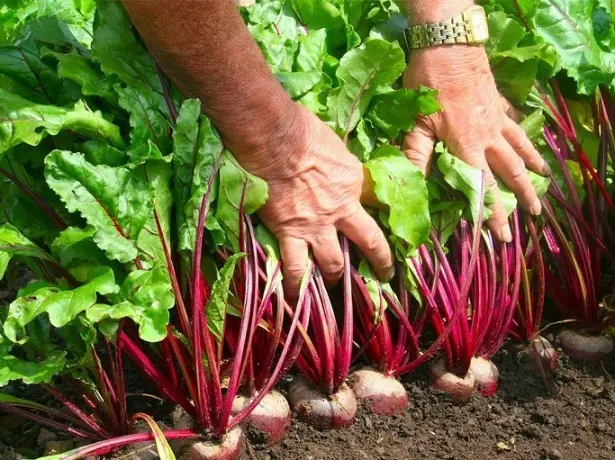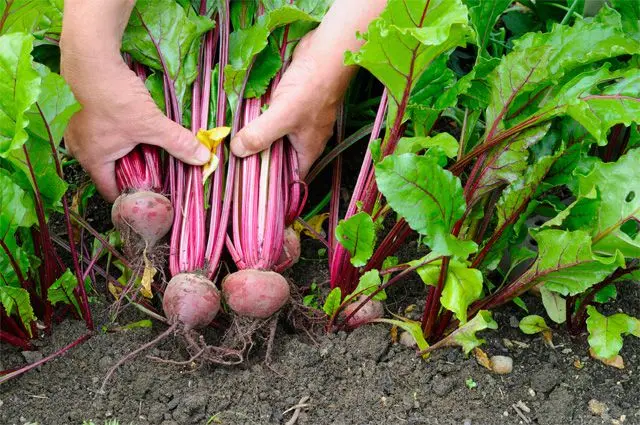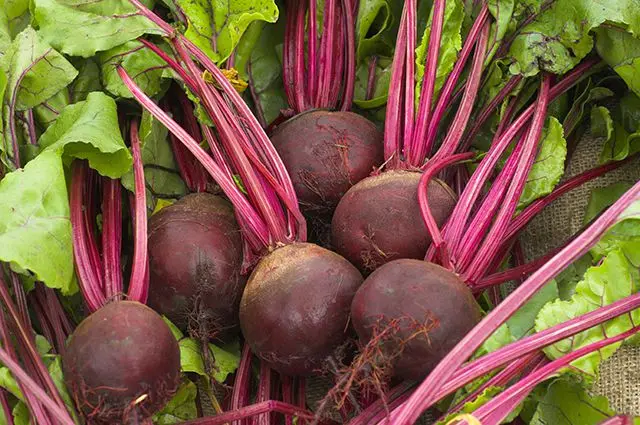Contents
The process of picking beets is a very important event for every experienced, and especially beginner, gardener. Therefore, it is necessary to know all the nuances of this matter – how to find out the time of harvest, how to correctly, so as not to damage the roots when digging, to collect it, and what is the yield of different varieties of beets.
How to guess pickup time
Beets should be harvested before the onset of autumn frosts. Do not rush and harvest beets too early – if you do this at the end of summer, you can get vegetables that have not had time to ripen, in which all the useful substances will not form.

Also, it is not necessary to harvest table beets very late, because with the arrival of frosts you will dig up root crops unsuitable for consumption and storage from the site. Even the selection of the best varieties of vegetables and proper care for them can come to naught if the table beet harvest is not done on time.
How can you know for sure if the time has come to harvest your favorite root crops? For this, there are some accurate signs that can help both beginners and experienced gardeners. So, if the vegetables have grown to the diameter that is considered characteristic of this variety of table beet, specific growths are visually visible on the surface of the root crop, the lower tops have become yellow and dry, and weather forecasts indicate the imminent onset of the first frosts – you can be sure that the harvest time the harvest has arrived.

Also, risk factors for this vegetable are prolonged rains, because after them the roots can not only crack in the soil, but also begin to rot. Thus, if the autumn turned out to be rainy, then it is also not worth delaying the beet harvest. Every year and depending on the region, the timing of the collection of this vegetable crop may vary slightly. In some areas, they will fall at the beginning of September, and in others – at the end of October. On average, dry and clear weather before the temperature is stable at +5, but before the period when the ground begins to freeze, can also serve as a guideline for harvesting.
Everyone knows that there are three types of beets – table, sugar and fodder. In any case, removed from the site in time and placed in a safe place, it will be perfectly stored for a long time and will retain not only its rich vitamin composition, but also excellent taste characteristics. The timing of the harvest of table, sugar and fodder beets is almost the same. The only nuance when harvesting table beets should be called the fact that, depending on the variety, the terms can shift – for example, root crops with an early ripening period reach full maturity already 50 days after planting. But among gardeners, varieties with a late ripening period have gained great popularity, since they are able to boast a high degree of keeping quality.
Productivity of different types
Under the condition of growing beets on an industrial scale, the weight of vegetables and the amount of root crop per 1 ha will greatly depend on the timing of its harvesting from the site. That is why in those farms where this vegetable crop has been successfully planted and grown for many years, special attention is paid to the question of when to start harvesting.

Many gardeners are also concerned about the yield of different types of beets per 1 ha. After all, not everyone grows it both for their own needs, and for livestock feed, and for sale, in order to get a certain profit. So, what is the average yield of different types of your favorite root crop from 1 hectare of usable area?
As the experience of many summer residents shows, the yield of table beets from 1 ha can be approximately 40 to 50 tons. This is relevant if the sowing rate of planting material, that is, seeds, will be about 16 – 20 kg per 1 ha. Many experienced gardeners who successfully grow highly productive modern varieties of this root crop, using the drip irrigation method, manage to obtain higher beet yields – up to 90 tons per hectare.

As you know, sugar beet, which gardeners in almost all regions of our country have been growing for many years, cannot boast such a large yield as its predecessor. According to experts, the average yield of this type of vegetable can be up to 18 tons per 1 ha. If we take the data of individual regions of Our Country, then, for example, in the Belgorod Region and the Krasnodar Territory, it is possible to collect about 30 tons of sugar beet from 1 hectare of usable area. Unfortunately, our country is not yet the undisputed leader in this matter, since in some European countries, as well as the USA, the yield of the same type of vegetables can reach about 60 tons per 1 ha.
If we talk about the yield of fodder beets, which worries all those summer residents who have decided to start livestock for their own needs or for sale, then its indicators are somewhat different from the two previous types of root crops. The yield of fodder beet can range from 30 to 60 tons per 1 ha of land. Moreover, in the case when it is possible to collect about 60 tons of this vegetable, at the same time the livestock owner receives a pleasant bonus in the form of 30 centners of tops. The highest result of the fodder beet harvest that has been harvested in our country at the moment is about 172 tons per 1 hectare. Proper planting of the root crop, as well as compliance with all generally accepted norms of agricultural technology, the use of high-quality dressings and special biological products can help increase the yield of beets from 1 ha in our country, which gives hope to many gardeners.
Video “How to properly clean and store”
How to collect correctly
In order to properly harvest beets, you will need special garden tools, as well as a knife with a sharpened blade and a container where you will put the root crops. They will need to be carefully dug up using a shovel or fork for this purpose, and then removed from the ground together with the tops. Then, when the beet is in your hands, it must be cleaned by removing the earth from the surface of the vegetable. After that, the root crops should be placed in a dry place so that they can dry well.

When you remove all the beets from the garden, and it dries normally (this will take about a couple of hours), you will need to cut the tops with a knife. This procedure is carried out carefully, leaving small processes, the length of which should be no more than 2 cm.
You should not postpone pruning the tops for a long time, as it has the ability to suck out useful substances from vegetables. After the cutting of the tops is completed, the vegetables should again be dried well. Experts do not recommend storing the resulting crop quickly, it must first be kept at a temperature of about 10 – 12 degrees for a couple of days. This is necessary so that the wounds on the roots can heal and dry.

Since beet picking is a common event for all gardeners, most often it is successful. The main thing during the harvest of your favorite root crop is to try to avoid mechanical careless damage to the surface of vegetables and correctly trim the tops. From what will be the terms and methods of preserving this vegetable crop, it directly depends on how long the tops will be cut. If your plans include keeping it safe and sound until the beginning of spring, then the cuttings should be left about 2 cm long.
In the case when they want to save the beets until a new crop is obtained next season, the tops are cut right along with part of the vegetable head. This is done so that your favorite vegetable does not begin to germinate. But in this case, it must be remembered that it will take more time for the minor damage received during the trimming process to heal. Also, during the storage of beets in this case, it will need to be monitored periodically to prevent rotting of the root crops.
Video “Mineral nutrition of sugar beets”
You will learn how to conduct proper and healthy nutrition of the sugar beet crop from the video.









